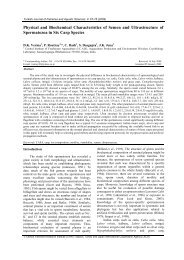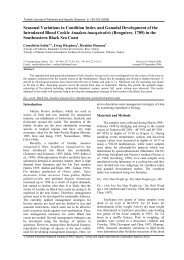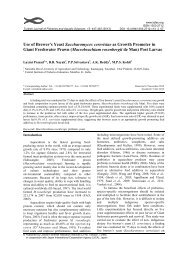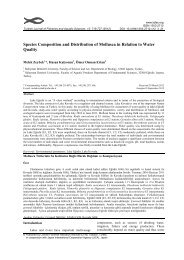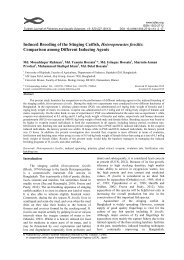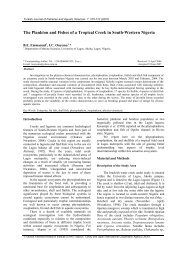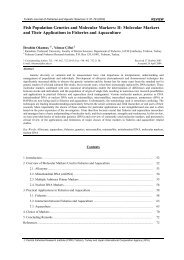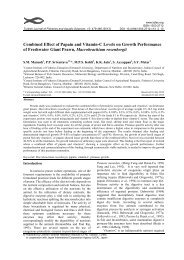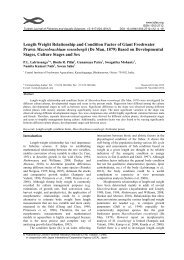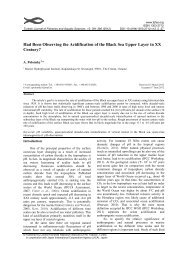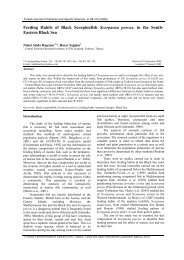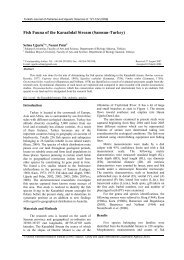Commercial Fishery Impact on the Modern Black Sea Ecosystem: a ...
Commercial Fishery Impact on the Modern Black Sea Ecosystem: a ...
Commercial Fishery Impact on the Modern Black Sea Ecosystem: a ...
- No tags were found...
Create successful ePaper yourself
Turn your PDF publications into a flip-book with our unique Google optimized e-Paper software.
78 V. N. Eremeev and G. V. Zuyev / Turk. J. Fish. Aquat. Sci. 7: 75-82 (2007)Table 1. Species compositi<strong>on</strong> of <strong>the</strong> <strong>Black</strong> <strong>Sea</strong> landings in <strong>the</strong> end of 1960s - beginning of 1970-s and in 1988s (%) (Ivanovand Bevert<strong>on</strong>, 1985; FAO yearbook, 2004)Species1960 - 1970ss 1988sThousand t<strong>on</strong>nes % Thousand t<strong>on</strong>nes %Anchovy 53.6* 67.7*Sprat 1.6* 69.88.6*93.4Horse mackerel 12.5* 12.6*Whiting 2.1*4.5*Atlantic b<strong>on</strong>ito 16.1 1.7Mackerel 1.2 1.5Bluefish 3.2 30.21.26.6Shad 0.8 0.2Turbot 2.0 0.2Picked dogfish 1.5 0.7Thornback ray 0.9 0.2Mugils 2.6 0.3Red mullet 1.7 0.5Sturge<strong>on</strong>s 0.2~ 0.01Total 182.8 100 783.8 100* Small short cycle fish speciesAno<strong>the</strong>r proof of <strong>the</strong> <strong>Black</strong> <strong>Sea</strong> fish overexploitati<strong>on</strong>evidences <strong>the</strong> decrease of anchovy of midsize and mid age in <strong>the</strong> end of 1980s testifying<strong>the</strong>reby “rejuvenati<strong>on</strong>” of <strong>the</strong> populati<strong>on</strong>. On <strong>the</strong>c<strong>on</strong>trary, weakening of fishing pressure <strong>on</strong> itspopulati<strong>on</strong> in <strong>the</strong> following years challenged a reverseeffect, namely, <strong>the</strong> size- age structure rehabilitati<strong>on</strong>and its catch increase (Figure 5). Thus drastic fall oftotal catches in 1989s might have been predictedbeforehand and <strong>on</strong>ly <strong>the</strong> emergence of two highlyproductive generati<strong>on</strong>s of horse mackerel in 1983sand 1984s arrested it for some years.In additi<strong>on</strong>, <strong>the</strong> imbalance in a “stock and catch”relati<strong>on</strong>ship in 1980s is exhibited in peculiarities of<strong>the</strong> l<strong>on</strong>g-term “stock and catch” dynamics indices. Asit is seen in <strong>the</strong> figure, <strong>the</strong> catch curve is equal in formto that of <strong>the</strong> stock retarding for 4-5 years (Figure 6).Thus <strong>the</strong> peak for <strong>the</strong> stock in 1979s wasaccompanied by peak for <strong>the</strong> catch in 1984s,minimum of <strong>the</strong> stock in 1983s was attended with thatof <strong>the</strong> catch in 1987s. And again <strong>the</strong> peak for <strong>the</strong>stock in 1984s was followed by <strong>the</strong> catch peak in1988s. It could hardly be regarded as incidentalcoincidence. Present temporal intervals corresp<strong>on</strong>d to<strong>the</strong> life span of <strong>on</strong>e generati<strong>on</strong> of <strong>the</strong> maincommercial species - anchovy and horse mackerelc<strong>on</strong>stituted in <strong>the</strong> end of 1970s more than 75% of totallandings. Correlati<strong>on</strong> coefficient value between stockwithin 1979-1987ss and catch within 1983-1991sswas equal to 0.748 (p < 0.02). In this c<strong>on</strong>necti<strong>on</strong>, <strong>the</strong>positi<strong>on</strong> of a number of scientists holding to <strong>the</strong> ideaof “<strong>the</strong> fatal” role of Mnemiopsis leidyi in sharpdecline of <strong>Black</strong> <strong>Sea</strong> catches doesn’t seem to be ra<strong>the</strong>rc<strong>on</strong>vincing.Phenomen<strong>on</strong> of Mnemiopsis “outburst” attainingits high point in 1989s suggests <strong>the</strong> directc<strong>on</strong>sequence of biomass decrease in small fishplanktophagous (anchovy, horse mackerel and o<strong>the</strong>rs)resulted from overfishing (Figure 7). Only due tosmall numbers of <strong>the</strong>se fish, Mnemiopsis leidyi turnedout to be competitive to <strong>the</strong>se planktophagous in agiven ecological niche. In 1988s as compared to1979s, <strong>the</strong> commercial fish stocks reduced more than<strong>on</strong>e and a half-fold: from 2200 thousand t<strong>on</strong>nes to1400 thousand t<strong>on</strong>nes. Finally, <strong>the</strong> ecological nicheoccupied by fish planktophagous appeared to bepartly empty and corresp<strong>on</strong>dingly, according to <strong>the</strong>general ecological rule “nature abhoret vacuum”,was occupied by Mnemiopsis.Al<strong>on</strong>g with Mnemiopsis, <strong>the</strong> crucial role instructural and functi<strong>on</strong>al alterati<strong>on</strong>s of <strong>the</strong> ecosystemin <strong>the</strong> north-west of <strong>the</strong> <strong>Black</strong> <strong>Sea</strong> played <strong>the</strong>extensive commercial bottom sprat trawlingscommenced in 1970s of <strong>the</strong> 20th century. Since 1979still 1986s, more than 120 thousand operati<strong>on</strong>s wereperformed in <strong>the</strong> NW shelf of <strong>the</strong> <strong>Black</strong> <strong>Sea</strong>. Ascompared to <strong>the</strong> previous period, <strong>the</strong> volume of spratcatch appeared to be increased as much as 15-20times during some years. Bottom trawling affecteddirectly <strong>the</strong> sea ecosystem by mechanic destructi<strong>on</strong> ofbottom biotops by trawlboard and low headline,respectively damaging or completely destroyingbenthic communities.Much more deleterious influence <strong>on</strong> <strong>the</strong>ecosystem was exerted by bottom sediments (peliticfracti<strong>on</strong>s) raised into <strong>the</strong> pelagic layer. It inducedsec<strong>on</strong>dary eutrophicati<strong>on</strong> and water polluti<strong>on</strong>, declineof its transparency, depressi<strong>on</strong> of photosyn<strong>the</strong>sisprocesses. However, <strong>the</strong> main negative factor ofbottom trawlings was recognized silting of vastbottom areas. Thus pelitic particles from TarkhancutCape of <strong>the</strong> Crimea peninsula spread with <strong>the</strong> currentfor <strong>the</strong> distance of 150-200 km (Figure 8). Totally,more than 5 thousand square km of <strong>the</strong> shelf weresilted as an outcome: at larger parts, <strong>the</strong> silt layerthickness varied from 2 till 5 cm, attaining up to 40-50 cm in spots. In a period of 1976-1984ss, some siltdepositi<strong>on</strong>s raised into <strong>the</strong> water layer c<strong>on</strong>stituting
V. N. Eremeev and G. V. Zuyev / Turk. J. Fish. Aquat. Sci. 7: 75-82 (2007) 7914132- 350- 300Length, cm1210861- 250- 200- 150- 100Catch, thous. t<strong>on</strong>ns41987/88 1988/89 1989/90 1990/91 1991/92 1992/93 1993/94 1994/95YearsFigure 5. Dynamics of size compositi<strong>on</strong> in <strong>the</strong> <strong>Black</strong> <strong>Sea</strong> anchovy in 1987 - 1993ss (1 - mid length cm, 2 - catch, thous. ts.)(Gucu, 1997).25002000R 2 = 0.559p < > 0.0212001000Stock thous. ts1500100054412800600Catch thous. ts50040001970 1973 1976 1979 1982 1985 1988 1991 1994 1997 2000YearsFigure 6. Dynamics of stock and catch in <strong>the</strong> <strong>Black</strong> <strong>Sea</strong> in 1970 - 2004s (1- stock, 2 - catch); 4, 4, 5 - explainati<strong>on</strong> in <strong>the</strong>text.20025001200Stock thous. ts.2000150010005003121050900750600450300Catch thous. ts.01970 1973 1976 1979 1982 1985 1988 1991 1994 1997 2000 2003YearsFigure 7. Dynamics of stock and fish catch in <strong>the</strong> <strong>Black</strong> <strong>Sea</strong> in 1970 – 2004ss. and Mnemiopsis biomass in 1988 – 1996 ss(1- stock, 2 - catch, 3 - Mnemiopsis ) (Prodanov et al., 1997, Bilio and Niermann, 2004).150
82 V. N. Eremeev and G. V. Zuyev / Turk. J. Fish. Aquat. Sci. 7: 75-82 (2007)Eremeev, V.N. and Zuev, G.V. 2005. Fish resources of <strong>the</strong><strong>Black</strong> <strong>Sea</strong>: l<strong>on</strong>g-term dynamics, regime ofexploitati<strong>on</strong> and perspectives of management. Marineecological journal, 4(2): 5-21 (in Russian).FAO 2004. FAO yearbook: <str<strong>on</strong>g>Fishery</str<strong>on</strong>g> Statistics. Captureproducti<strong>on</strong>, vol. 98/1.Grishin, A.N., Kovalenko., L.A. and Sorokolit, L.K. 1994.Trophic relati<strong>on</strong>s in plankt<strong>on</strong> communities of <strong>the</strong><strong>Black</strong> <strong>Sea</strong> before and after Mnemiopsis leidyi (A.Agassiz) invasi<strong>on</strong>. Proceedings of YugNIRO, 40: 38-44 (in Russian).Gubanov, E.P. 2005. Technogenic influence <strong>on</strong> <strong>the</strong> <strong>Black</strong><strong>Sea</strong> ecosystem and its c<strong>on</strong>sequences. Rybnoekhozyaistvo Ukrainy, 3/4: 14-18 (in Russian).Gubanov, E.P. and Serobaba, I.I. 2005. The state of <strong>the</strong>ecosystem and rati<strong>on</strong>al utilizati<strong>on</strong> of living resourcesin <strong>the</strong> Azov-<strong>Black</strong> <strong>Sea</strong> basin. Rybnoe khozyaistvoUkrainy, 1: 8-12 (in Russian).Gucü, A.C. 1997. Role of fishing in <strong>the</strong> <strong>Black</strong> <strong>Sea</strong>ecosystem sensitivity to changes: <strong>Black</strong> <strong>Sea</strong>, Baltic<strong>Sea</strong> and North <strong>Sea</strong>. The Ne<strong>the</strong>rlands: 149-162.Gucü, A.C. 2002. Can overfishing be resp<strong>on</strong>sible for <strong>the</strong>successful establishment of Mnemiopsis leidyi in <strong>the</strong><strong>Black</strong> <strong>Sea</strong> Estuarine, Coastal and Shelf Science, 54:439-451.Ivanov, L. and Bevert<strong>on</strong>, R. 1985. The Fisheries Resourcesof <strong>the</strong> Mediterranean. Part two: <strong>Black</strong> <strong>Sea</strong>. Stud. Rev.FAO, 60: Roma, 135 pр.Kideys, A.E., Kovalev, A.V., Shulman, G., Gordina, A.D.and Bingel, F. 2000. A review of zooplankt<strong>on</strong>investigati<strong>on</strong>s of <strong>the</strong> <strong>Black</strong> <strong>Sea</strong> over <strong>the</strong> last decade. J.Mar. Syst., 24: 355-371.Moiseev, P.A. 1969. Biological Resources of <strong>the</strong> WorldOcean. Pischevaya Promyshlennost, Moscow, 338 pp.(in Russian).Niermann, U., Kideys, A.E., Kovalev, A.V., Melnikov, V.and Belokopytov, V. 1999. Fluctiati<strong>on</strong> of pelagicspecies of <strong>the</strong> open <strong>Black</strong> <strong>Sea</strong> during 1980-1995 andpossible telec<strong>on</strong>necti<strong>on</strong>s. Envir<strong>on</strong>mental degradati<strong>on</strong>of <strong>the</strong> <strong>Black</strong> <strong>Sea</strong>: challenges and remedies. -KluwerAcademic Publisher, Dordrecht: 147-173.Prodanov, K., Mikhailov, K., Daskalov, G., Maxim, C.,Chashchin, A., Arkhipov, A., Shlyakhov, V.,Özdamar, E. 1997. Envir<strong>on</strong>mental Management ofFish Resources in <strong>the</strong> <strong>Black</strong> <strong>Sea</strong> and Their Rati<strong>on</strong>alExploitati<strong>on</strong>. General Fisheries Council for <strong>the</strong>Mediterranean, Studies and Reviews, No: 68.. Foodand Agriculture Organizati<strong>on</strong> of <strong>the</strong> United Nati<strong>on</strong>s,Roma, 178 pp.Rass, T.S. 1992. Fish resources of <strong>the</strong> <strong>Black</strong> <strong>Sea</strong> and <strong>the</strong>iralterati<strong>on</strong>s. Oceanology, 32(2): 293-302 (in Russian).Rass, T.S. 2001. The <strong>Black</strong> <strong>Sea</strong> regi<strong>on</strong> and its productivity.Journal of Ichthyology, 41(6): 742-749 (in Russian).Samyshev, E.Z., Rubinshtein, I.G., Zolotarev, P.N. andLitvinenko, N.M. 1986. Variati<strong>on</strong> in <strong>the</strong> structure of<strong>the</strong> <strong>Black</strong> <strong>Sea</strong> benthos under anthropogenic effects.Anthropogenic influences <strong>on</strong> <strong>the</strong> coastal marineecosystems. VNIRO, Moscow: 52-71 (in Russian)Shiganova, T.A. 1997 Mnemiopsis leidyi abundance in <strong>the</strong><strong>Black</strong> <strong>Sea</strong> and its impact <strong>on</strong> <strong>the</strong> pelagic community.Sensitivity to Changes: <strong>Black</strong> <strong>Sea</strong>, Baltic <strong>Sea</strong> andNorth <strong>Sea</strong>. Kluwer Academic Publisher, Dordrecht:117-131.Zaitsev, U.P., Phesunov, O.E. and Sinegub, I.A. 1999. Theinfluence of bottom trawling fishery <strong>on</strong> <strong>the</strong> ecosystemof <strong>the</strong> <strong>Black</strong> <strong>Sea</strong> shelf. Reports of Academy ofScience, 3: 156-158 (in Russian).Zuev, G.V, Gutsal, D.K., Melnikova, E.B., 2004. The <strong>Black</strong><strong>Sea</strong> sprat: myths and reality. Rybnoe KhozyaistvoUkrainy, 31(2): 12-14 (in Russian).



